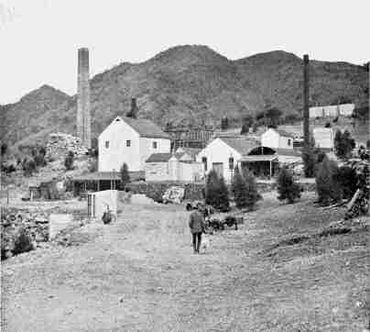Yudnamutana, South Australia facts for kids
Quick facts for kids YudnamutanaSouth Australia |
|
|---|---|

Copper smelters of Yudnamutana in 1910
|
|
| Established | 1862-1865 and 1903-1912 |
| Location | |

Yudnamutana (/jədnəˌmuːˈtɑːnə/ yəd-NƏ-moo-TAH-nə) is a historic mining valley in the Northern Flinders Ranges, located at Mount Freeling, North West of Arkaroola on the edge of the wilderness sanctuary. It is accessible by four-wheel drive from the south. Ancient mining sites give the opportunity for ecologically responsible bush camping, but no supplies are available. Walks across the crests of the mountains deliver splendid views over the Flinders Ranges into the plains of the outback. The northern pass hosts black rocks of magnetite.
History
Indigenous people
This area was inhabited by the Adnyamathanha tribe of Indigenous Australians for millennia before the arrival of Europeans. They were Stone Age hunter-gatherers and inhabited much of the area to the south.
European settlement
This area was first settled by pastoralists in the 1850s. Prospectors followed shortly after, hoping for another Burra style deposit.
Mining
A copper deposit was found, in 1859, by A. Frost and H. Gleeson. Yudnamutana was the site of an early South Australia copper mine. First mined in 1862, it reached fame in Adelaide shortly afterwards when a block of ore weighing 4 tonnes (3.9 long tons) was paraded through the streets. Copper concentrates were hauled to Port Augusta in drays by animals along rough tracks – a distance of about 300 kilometres (190 miles). This limiting factor affected the company's profitability. A drought in 1869 forced the closure of the mine because not enough water was available for animals that worked at the mine.
Another attempt was made at mining the site at the start of the 20th century. Transport was less costly this time – by dray for only 100 kilometres (62 miles) to the Central Australia Railway at Farina, then by train. The mine's proprietors tried to further reduce the cost of transport by instigating a road train to Farina railway station in 1909. However, the rough terrain and mechanical breakdowns soon ended the scheme.
A small smelter was constructed at Farina in 1909 or 1910, but it closed after only a few experiments and was demolished in 1938. The mine itself closed again by 1912. All that remains of this settlement are two large boilers, some mine shafts, some dugouts and the cemetery.


